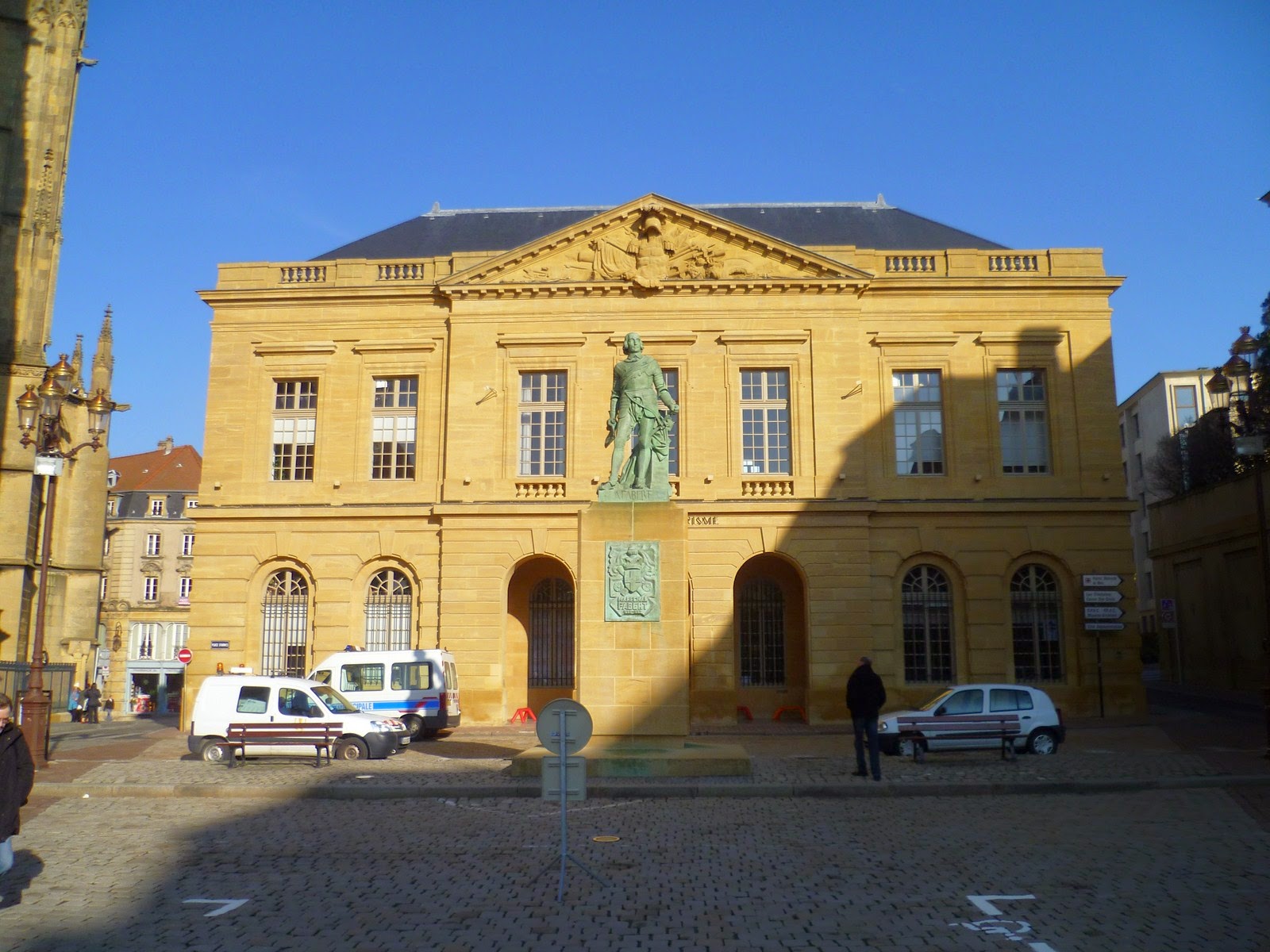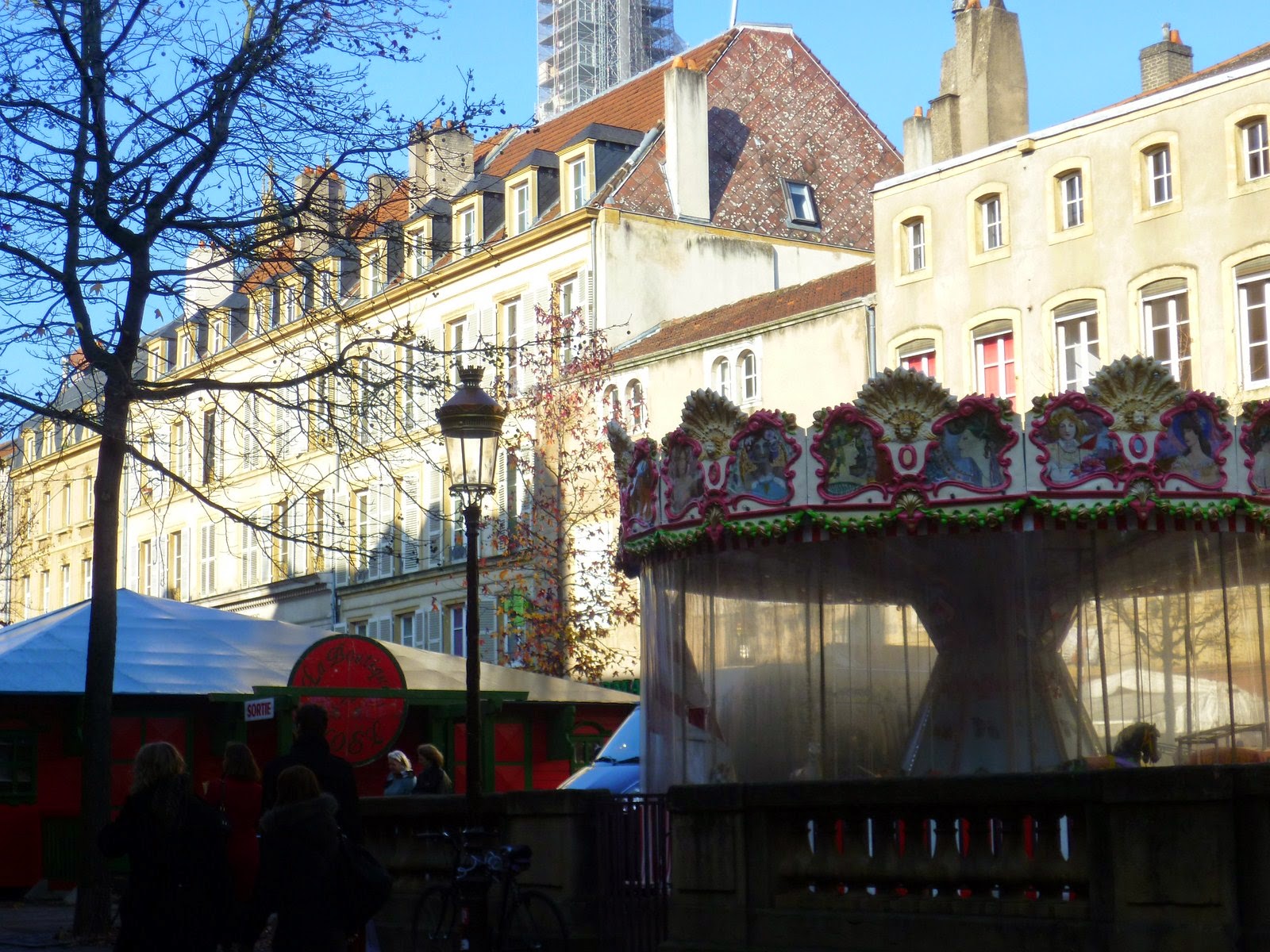Metz, prefectura del Departamento de Mosela y
capital de Lorena. Es una de las ciudades con mayor patrimonio medieval de
Francia. Metz se encuentra en la confluencia de los ríos Mosela y Seille. Esta
ciudad tiene muchos puentes y tres islas comunicadas entre sí. Situada a unos
50 km de Nancy, Luxemburgo y Estrasburgo, está a medio camino entre Estrasburgo
y Reims, y del mismo modo a medio camino entre París y Frankfurt am Main. En la
época galorromana, Metz fue anexionada a la Galia Belga, con capital en Reims.
Sus habitantes ocupaban desde el Argonne hasta los Vosgos. A lo largo de la
formación de Francia, Metz ha sido cruce de caminos entre las redes viarias de
las ciudades importantes del entorno: Lyons, Tréveris, Maguncia, Estrasburgo.
Metz tenía 15.000 ó 20.000 habitantes en época romana. Entre 511 y 751 se convirtió
en capital del Reino de Austrasia y luego pasó a formar parte del Sacro Imperio
como ciudad libre. A partir del siglo XI los edificios eclesiásticos se
multiplican y a partir del siglo XIII se convirtió en república oligárquica
regida por El Colegio de los Eclesiásticos. En el Renacimiento esta ciudad y
las de Toul y Verdún pasan a Francia como protectorados, situación auspiciada
por el propio César Carlos, y a partir del tratado de Westfalia en 1648, las
ciudades de los Tres Obispados pasan legal y definitivamente a Francia. A
partir de este momento la ciudad de Metz pasa a ser ciudad fortificada
militarmente por su condición de fronteriza con el Sacro Imperio. Metz fue
puntualmente ciudad pro Reforma luterana, pero volvió a la fe católica pronto.
Los judíos fueron autorizados a instalarse en la ciudad a partir de 1565 y su
comunidad alcanzaba las 2200 personas a partir del siglo XVIII. Desde 1870 con
la invasión alemana de 1870 y el final de la guerra franco-prusiana en 1871, hasta 1919 (firma del Tratado de Versalles),
pasó a ser capital de Lorena en el Territorio Imperial de Alsacia y Lorena.
Después de la anexión, la ciudad se germaniza rápidamente en sus símbolos y sus
nuevos edificios emblemáticos, de arquitectura alemana. En 1914 la ciudad es el
mayor fuerte del Imperio Alemán, pero la ciudad fue ignorada durante la Primera
Guerra Mundial. No entraba en los planes de los oficiales de ningún bando. Con
más de 300 cafés, Metz se convirtió, tras el armisticio, en una pequeña París,
si bien la ciudad conservó el bilingüismo adquirido en el período imperial
germano hasta bien entrada la década de 1980. Ocupada y anexada de nuevo en la
Segunda Guerra Mundial, Metz se convirtió en la Marca Oeste del Reich hasta noviembre
de 1944, cuando la 95ª División de Infantería USA liberó la ciudad.
Metz, prefecture of the department of Moselle and
the capital of Lorraine. It is one of the cities with the highest medieval
heritage of France. Metz is located at the confluence of the Moselle and the
Seille rivers. This city has many bridges and three islands interconnected. It
is situated about 50 km from Nancy, Luxembourg and Strasbourg and it is halfway
between Strasbourg and Reims, and likewise halfway between Paris and Frankfurt
am Main. In Gallo-Roman times, Metz was annexed to the Belgian Gaul, with its
capital at Reims. Its inhabitants occupied from the Argonne to the Vosges.
Throughout the formation of France, Metz has been a crossroads between the road
networks of major cities nearby: Lyons, Trier, Mainz and Strasbourg. Metz had
15,000 or 20,000 inhabitants in Roman times. Between 511 and 751 it became the
capital of the Kingdom of Austrasia and then became part of the Holy Roman
Empire as a free city. From the eleventh century church buildings multiply and
from the XIII century the city became an oligarchic republic governed by The
College of Ecclesiastical. In the Renaissance this city with Toul and Verdun entered
France as protectorates, a form of state sponsored by Emperor Charles V, and
from the Treaty of Westphalia in 1648, the cities of the Three Bishoprics legal
and definitely went to France. From this time the city of Metz becomes
militarily fortified town for being a border with the Holy Roman Empire. Metz
city was promptly pro Lutheran Reformation, but returned to the Catholic faith
soon. The Jews were allowed to settle in the city from 1565 and 2200 amounted
community people from the eighteenth century. Since 1870 with the German
invasion and the end of the Franco-Prussian War in 1871, until 1919 (Treaty of
Versailles), it became the capital of Lorraine in the territory of Alsace-Lorraine.
After the annexation, the city was quickly germanized in its symbols and its
new landmark buildings were of German architecture. In 1914 the city is the
largest fort in the German Empire, but it was ignored during World War I. It
was not in the plans of the officers of either side. With over 300 cafés, Metz
became, after the armistice, a small Paris, but the city retained bilingualism
acquired in the German imperial period until well into the 1980s. Occupied and
annexed again in WWII , Metz became the West Limit of the Reich until November
1944, when the US 95th Infantry Division liberated the city.













































